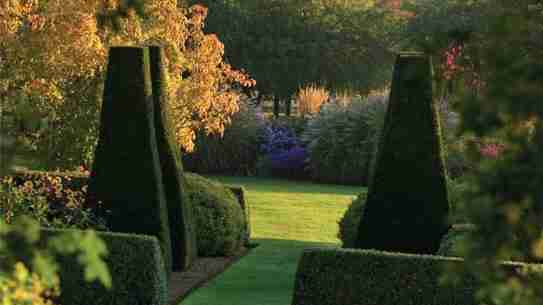April 19,2024
A New Book Celebrates the Beauty of Contemporary English Gardens
by David Stewart
What makes an “English garden” English? Must they all be luxurious herbaceous borders lashed with climbing roses and speckled with violets as though they leapt straight out of a storybook? Thankfully, as intelligently detailed in The New English Garden (Frances Lincoln, $60), the answer is an emphatic no.

Written by Daily Telegraph garden columnist Tim Richardson, the book tours 25 estate-size British properties that are described as having been “made or remade over the past decade,” which slyly allows in some oldies but goodies (among them Great Dixter and Prince Charles’s gardens at Highgrove) under the wire. Most of the gardens are fairly edgy and inarguably inspiring—though an overwrought acreage scattered with mysterious runes makes an appearance, which says more about accessorizing than it does about gardening. So does the living wall clamped to the exterior of the Athenaeum Hotel in London, a gravity-challenged innovation that, in my humble opinion, has run its course.
That being said, even readers with only a vest-pocket backyard to till can find ideas worth adapting on a smaller scale—and with far less staff. Several of the most stunning gardens bear the influence of the New Perennial movement and its emphasis on meadowlike choreographies of wildflowers, exotic grasses, and dramatic weeds. Tom Stuart-Smith’s daredevil reworking of the once-astounding 19th-century parterre at Trentham is a breathtakingly successful case in point, a wild and woolly evocation of the Victorian propriety that came before. Sir Evelyn and Lady de Rothschild’s Lynn Garden, designed by the father-and-son team of Jacques and Peter Wirtz, on the other hand, is a triumph of elegant earthmoving, a largely green-on-green environment shaped with swelling artificial hillocks and shimmering canals that seems tailor-made for a remake of Last Year at Marienbad.
Not every garden featured is grandiose in scale or feeling. Highgrove, one of the most old-fashioned gardens that Richardson addresses, is a lesson in how to knit together a landscape with a network of spaces both intimate and breathtaking. My favorites, though, are a toss-up between Jinny Blom’s heavenly canal garden in Gloucestershire, which could easily be reduced in size for an urban townhouse, and Stuart-Smith’s exuberantly colored, prairielike terraces for a client in North Yorkshire, which would make for a fantastic front yard and be the envy of the neighborhood.
For a sampling of the breathtaking photographs featured in The New English Garden, click here.






